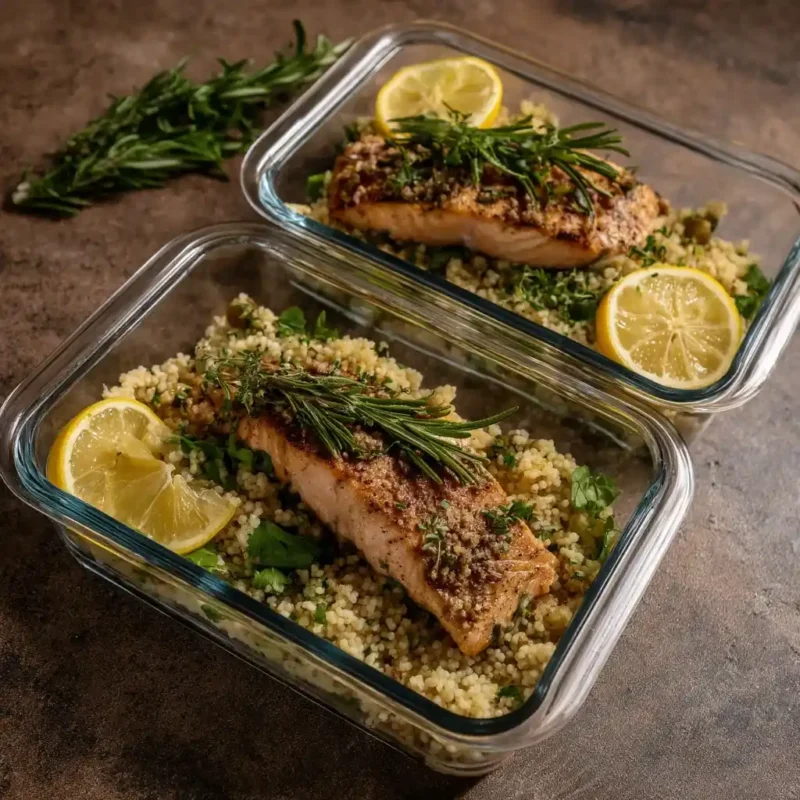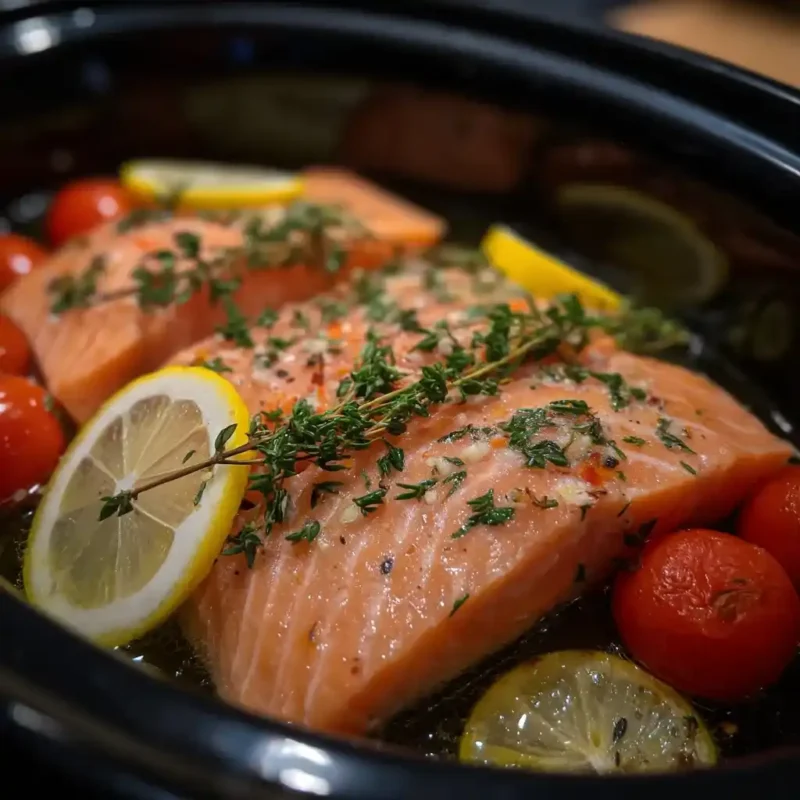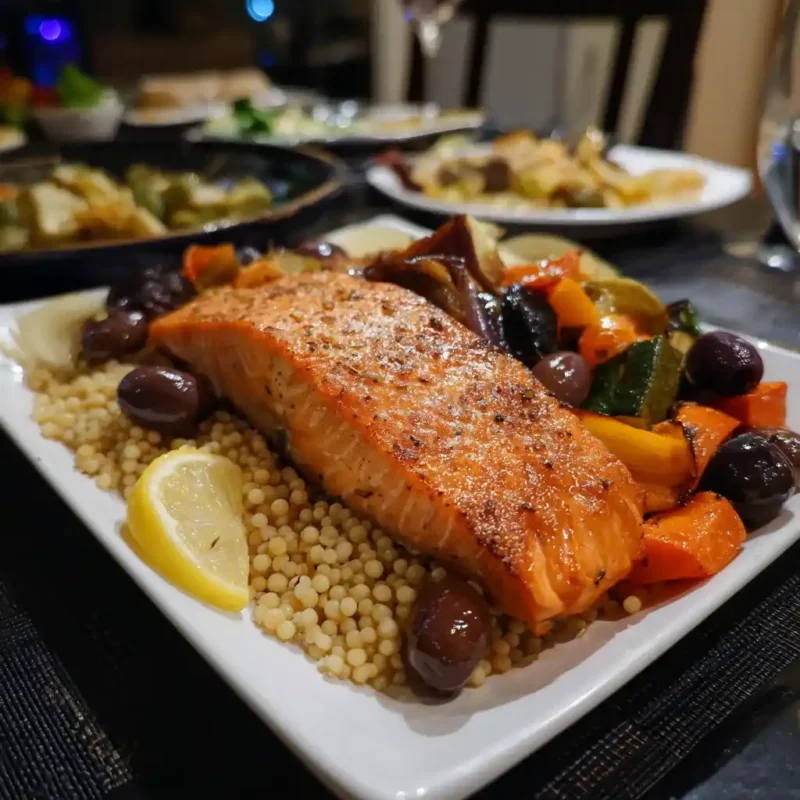A Coastal Memory, A Culinary Revelation

It was on a quiet afternoon in a seaside town along the Amalfi Coast where I first tasted salmon unlike any other—tender, citrusy, and infused with herbs so fragrant it felt like the sea breeze had seasoned the dish itself. The secret, the chef revealed with a wink, wasn’t some extravagant technique or secret spice—it was time. More specifically, the magic of slow cooking.
Fast forward to today, and the question still lingers in kitchens across the U.S.: Is slow cooking good for salmon? Especially for those following a Mediterranean diet, where flavor and wellness go hand in hand, this method is more than convenient—it’s transformational.
In this article, we’ll explore the science, flavor, and health benefits behind gently cooking salmon in a slow cooker. You’ll learn how it compares to searing or baking, why Mediterranean cooks rely on it, and how you can integrate it into your weekly meal plan for maximum nourishment and flavor.
Check out our bold and delicious Best Crockpot Mediterranean Salmon 2025 for a complete guide and recipe.
Table of contents
- A Coastal Memory, A Culinary Revelation
- PART 1: The Science Behind Slow Cooking Salmon
- PART 2: Mediterranean Cooking Techniques That Enhance Salmon
- PART 3: Comparing Cooking Methods for Salmon: Which Is Best?
- PART 4: How to Incorporate Slow-Cooked Salmon into a Healthy Mediterranean Diet
- FAQ – Is Slow Cooking Good for Salmon?
- Conclusion
PART 1: The Science Behind Slow Cooking Salmon
How Slow Cooking Affects Salmon Texture and Flavor

One of the main reasons chefs and home cooks alike praise slow-cooked salmon is its unmatched tenderness. When you cook salmon at low heat for a longer time, the connective tissue breaks down gently. This results in a buttery, fork-tender texture that’s nearly impossible to achieve with high-heat methods like pan-searing or broiling.
Unlike high temperatures that can dry out or scorch the outer layers before the inside cooks, slow cooking allows for even heat distribution. This gives the salmon a moist interior and preserves its naturally rich oils—especially important when preparing wild-caught or fatty salmon varieties rich in omega-3s.
In Mediterranean cuisine, preserving the integrity of ingredients is foundational. That’s why herbs like oregano, oils like extra virgin olive oil, and aromatics like garlic and lemon zest are slow-cooked rather than seared. These elements gently infuse the salmon, enhancing every bite without overpowering its delicate flavor.
“Cooking salmon gently brings out the natural oils and allows aromatic herbs to infuse without overpowering the fish’s delicate taste,” says one Greek home chef.
For another slow-cooked seafood twist, try our Cajun Honey Butter Salmon — a bold fusion of heat and Mediterranean heart.
Nutrient Retention in Low-Heat Salmon Cooking
Beyond taste, nutrient preservation is another big win for the slow cooker method. High heat can degrade important micronutrients, especially B vitamins and omega-3 fatty acids, which are crucial for brain and heart health. With slow cooking, you retain more of these vital nutrients, making the dish both satisfying and functional.
The Mediterranean diet—often called the world’s healthiest way to eat—prioritizes anti-inflammatory foods. Salmon, with its high levels of EPA and DHA (two powerful omega-3s), fits this model perfectly. But when cooked at high temperatures, these delicate fats can oxidize. Slow-cooked Mediterranean salmon, on the other hand, retains its anti-inflammatory power, which contributes to:
- Lower blood pressure
- Improved cholesterol profiles
- Enhanced cognitive health
- Reduced inflammation
It’s no wonder that heart-healthy salmon recipes are a staple in Mediterranean households. When prepared in a slow cooker, salmon becomes not only easier to digest but also better for you.
Pro tip: Add lemon zest and fresh parsley after cooking for extra vitamin C and freshness without compromising heat-sensitive nutrients.
PART 2: Mediterranean Cooking Techniques That Enhance Salmon
Why Mediterranean Cooks Prefer Low-and-Slow Methods
In Mediterranean kitchens, low and slow isn’t just a technique—it’s a way of life. This method is about honoring ingredients and extracting deep, layered flavor over time. Rather than rushing the process, Mediterranean cooks embrace slow simmering and gentle braising—exactly what a crockpot delivers.
As you’ll see in our flavor-packed Mediterranean Chicken Tacos, time allows spices to mellow and herbs to meld into oils, resulting in dishes that are as balanced as they are bold.
In Mediterranean salmon recipes, this philosophy shows up through the use of:
- Olive oil for moisture
- Lemon zest for brightness
- Fresh dill or oregano for herbaceous depth
- Garlic and cherry tomatoes for richness
Want to explore more traditional prep techniques? Try our rich and satisfying Mediterranean Salmon Recipe—an oven-baked variation rooted in authentic flavor.
Signature Mediterranean Ingredients That Shine in a Crockpot
When it comes to building flavor in the slow cooker, ingredient selection is everything. The Mediterranean diet emphasizes clean, natural ingredients that not only taste great but also support heart and brain health. These components are ideal for low-and-slow cooking, where they can meld and mellow over time.
Here are the top Mediterranean ingredients that shine when slow-cooked with salmon:
| Ingredient | Why It Works in a Slow Cooker |
|---|---|
| Olive oil | Rich in healthy fats; prevents drying, adds silkiness |
| Garlic (whole/minced) | Deepens flavor slowly, adds aroma |
| Lemon slices & zest | Infuses brightness, balances salmon’s richness |
| Cherry tomatoes | Break down into a sweet, jammy sauce around the salmon |
| Kalamata olives | Add briny contrast; great for depth of flavor |
| Fresh parsley or dill | Used at the end for freshness and color contrast |
| Dried oregano & thyme | Infuse slowly without becoming bitter |
These ingredients work synergistically to elevate salmon without overpowering its delicate flavor profile. And when slow-cooked, they develop even deeper character—garlic softens, tomatoes sweeten, and herbs melt into the oil.
This low-and-slow style also supports a low-sodium, anti-inflammatory approach, which aligns perfectly with wellness-forward diets in both the U.S. and Mediterranean regions.
Want the best of both worlds? Check out our oven-finished favorite: Lemon Butter Salmon with Crispy Potatoes and Broccoli
PART 3: Comparing Cooking Methods for Salmon: Which Is Best?
Slow Cooking vs. Baking vs. Pan-Searing
Not all salmon is cooked equally—and not all methods yield the same results when it comes to flavor, texture, and health retention. Let’s break down the three most common cooking methods—slow cooking, baking, and pan-searing—to understand when and why each might be best.
| Cooking Method | Pros | Cons | Best For |
|---|---|---|---|
| Slow Cooking | Moist, tender texture, deep flavor infusion, nutrient retention | Requires planning/time, not ideal for crispy skin | Weeknight meals, meal prep, Mediterranean slow-cooked salmon |
| Baking | Easy, hands-off, good for seasoning control | Can dry out salmon if overcooked, less flavor infusion | Quick healthy meals, large servings |
| Pan-Searing | Crispy skin, fast, beautiful color | Higher risk of overcooking, requires attention | Restaurant-style meals, presentation focus |
In short, slow cooking salmon gives you unbeatable tenderness, especially when using herbs, lemon, and olive oil, as found in many Mediterranean fish recipes. It allows for a more even flavor profile and doesn’t sacrifice nutrition—a key consideration if you’re following a heart-healthy or anti-inflammatory meal plan.
Check out our Gordon Ramsay-Inspired Salmon Crockpot Tips to learn how fine-dining principles are adapted to the slow cooker.
Ideal Times to Use a Slow Cooker for Salmon
While not every dish calls for the slow cooker, certain moments make it the perfect salmon-cooking tool:
- Busy weeknights – Toss ingredients in during lunch break, come home to dinner
- Meal prepping – Cook once, use salmon in bowls, wraps, or salads throughout the week
- Dinner parties – Let the crockpot work while you focus on sides and drinks
- Low-fat, nutrient-rich meals – Slow cooking avoids burning delicate omega-3s and B vitamins
One of the standout features of slow-cooked salmon is how forgiving it is. Unlike oven-baking, which can quickly dry out the fish, or pan-searing, which requires a watchful eye, slow cooking keeps the temperature low and moisture high.
This makes it ideal for:
- Salmon with lemon and herbs
- Olive oil salmon slow cooked with tomatoes
- Garlic-infused, Mediterranean-style salmon fillets
It’s a meal-prep hero, as seen in our 15 Mediterranean Diet Crockpot Recipes—each dish designed to save time and support wellness.
Looking for comfort food variety? Don’t miss our savory Slow Cooker French Onion Soup Mix Chicken.
PART 4: How to Incorporate Slow-Cooked Salmon into a Healthy Mediterranean Diet
Weekly Meal Planning with Slow-Cooked Salmon

Incorporating slow-cooked Mediterranean salmon into your week isn’t just smart—it’s incredibly satisfying. Thanks to its flavor versatility, high protein content, and anti-inflammatory benefits, slow-cooked salmon becomes the kind of meal prep staple that never feels repetitive.
Here’s how you can make it work all week:
| Day | Meal Idea | Mediterranean Ingredients Used |
|---|---|---|
| Monday | Slow-Cooked Salmon + Quinoa + Roasted Veggies | Oregano, garlic, olive oil |
| Tuesday | Salmon Wrap with Tzatziki, Arugula, Cherry Tomatoes | Dill, cucumber, lemon |
| Wednesday | Salmon Flakes on Greek Couscous Salad | Kalamata olives, red onion |
| Thursday | Mediterranean Salmon Bowl | Brown rice, parsley, hummus |
| Friday | Cold Salmon + Tomato Cucumber Salad | Sun-dried tomato, mint |
This flexible base allows you to pair the salmon with rotating grains, legumes, or greens—making it ideal for low-carb, gluten-free, or Mediterranean-style eating plans.
And since slow-cooked salmon retains its moisture, it holds up well in the fridge and reheats without turning rubbery—unlike pan-seared or grilled versions.
Don’t miss our refreshing Mediterranean Tomato Cucumber Salad—a perfect pairing for leftover salmon.
Pairing Slow-Cooked Salmon with Mediterranean Side Dishes
No Mediterranean meal is complete without the right accompaniments. Since slow-cooked salmon is juicy, citrusy, and rich in flavor, you’ll want sides that balance and complement, not compete.
Here are go-to Mediterranean sides to elevate your salmon:
- Lemon couscous with fresh parsley and olive oil
- Oven-roasted eggplant, zucchini, and peppers tossed in oregano
- Warm lentil salad with sun-dried tomatoes and feta
- Chickpea tabbouleh with mint, tomato, and lemon
- Greek-style potatoes roasted with rosemary and garlic
Pro tip: Add toasted pine nuts or a spoonful of hummus for texture and protein.
And for the perfect finishing touch? A drizzle of olive oil, a pinch of sea salt, and a sprinkle of fresh herbs like dill or parsley just before serving.
Looking for more Mediterranean side inspiration? Check out our bright Costco Mediterranean Salad—a crowd-pleaser with crunch.
These dishes work together to form a full plate: one that honors the balance of the Mediterranean diet, supports heart health, and satisfies your craving for real food done right.
FAQ – Is Slow Cooking Good for Salmon?
No—quite the opposite. Slow cooking salmon on low heat retains moisture, resulting in a tender, buttery texture. The key is not overcooking past the 2-hour mark and always including a bit of olive oil or broth for extra moisture.
Yes. It preserves heart-healthy omega-3 fatty acids and avoids the nutrient loss that can occur at high heat. When paired with Mediterranean herbs and vegetables, it supports anti-inflammatory, nutrient-rich eating.
Mediterranean spices like oregano, thyme, smoked paprika, crushed red pepper, and lemon zest complement the richness of salmon beautifully without overwhelming it.
Absolutely. It keeps well in the fridge for up to 3 days and can be used in wraps, salads, or bowls. It also freezes well for up to two months.
For hands-off convenience and moist results, yes. While baking is quicker, crockpot cooking allows more flavor absorption and minimizes risk of overcooking.
Lemon couscous, roasted vegetables, Mediterranean salads, and hummus platters are all excellent. Aim for sides with fresh herbs, olive oil, or briny elements like olives and feta.
Conclusion
So, is slow cooking good for salmon? From a Mediterranean culinary lens, it’s not just good—it’s ideal. This low-and-slow method offers:
- Unmatched tenderness
- Deep flavor infusion from herbs, lemon, and olive oil
- Better nutrient retention
- Incredible ease for weeknight cooking and meal prep
Whether you’re aiming for a heart-healthy lifestyle or simply crave rich, clean flavors, slow-cooked Mediterranean salmon is a go-to that nourishes and satisfies.
Dive into our Best Crockpot Mediterranean Salmon 2025
Satisfy your spicy cravings with Cajun Honey Butter Salmon
Love lemon? Try our crisp Lemon Butter Salmon with Crispy Potatoes and Broccoli
Want more visuals and new releases? Follow us on Pinterest for updates, tips, and Mediterranean kitchen inspiration!

3 thoughts on “Slow Cooking Salmon: Is It Healthy? A Mediterranean Take That Might Surprise You”